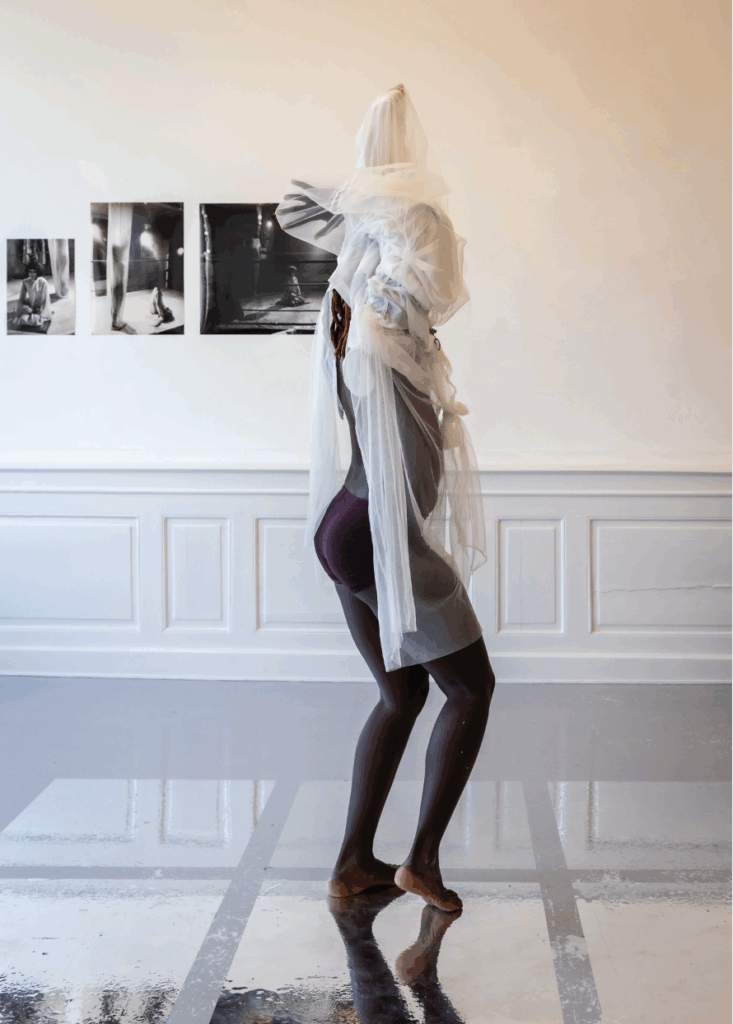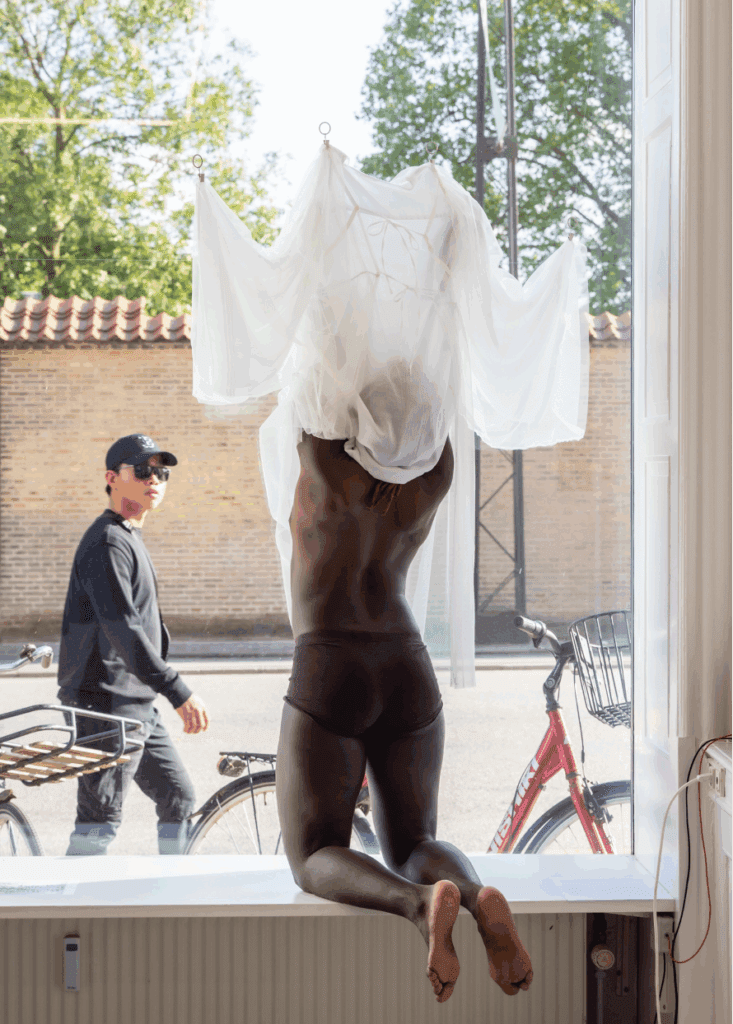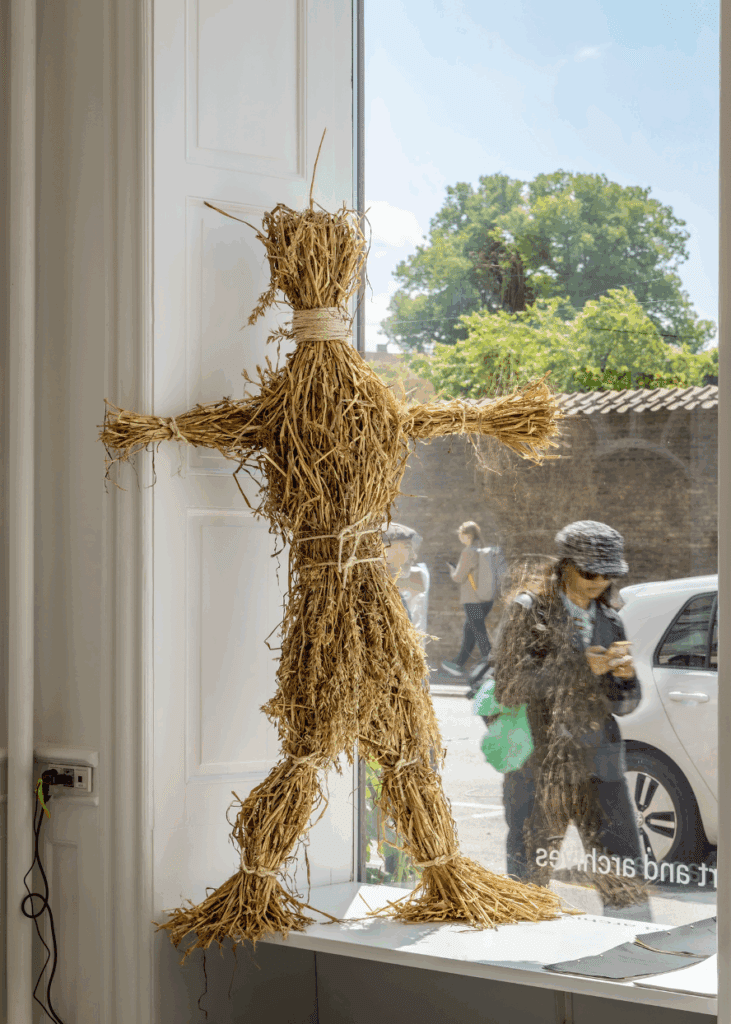– “Intense catharsis that could also be found in silence”
For the third interview in relation to the exhibition Disappearing Body – Becoming Tsujimura at Heirloom in Copenhagen, revolving around theJapanese performance artist Kazuko Tsujimura, I interviewed Portuguese born artist Body_hacker aka Sall Lam Toro.
Body_hacker is an antidisciplinary multimedia performance artist. Their work confronts what they call ‘the hijacked body’. Through rituals, glitches, errors, dialogues with eco-erotic companions, text, resonance, and emotion, Body_hacker develops poetic multiplicities of the body and radical imagination within anti-capitalist, anarchist, and collective liberation forms.
Karn Hald [KH]: I want to start by asking you about your relationship to Tsujimura through your practice – what kind of conversation do you have with her works, what does she bring to life in you?
Sall Lam Toro [SLM]: I guess the conversation began with our attachment to butoh dance as a practice even though our proximity to it is so different. I have seen parallels between our ways of conceptualizing dance and movement influenced by our butoh practices specifically around eco bodies – bodies of water, fauna, mountains, fields, etc.. But first, here’s a bit of context to butoh which, in Denmark, it doesn’t feel like it is a known dance /performing art form:
Takashi (2015) records butoh co-founder, Tatsumi Hijikata’s words on butoh as a “‘convulsion of existenc’ that opposes expression in the traditional sense, but rather provides a form that ‘expresses without expressing’” (p.007). That is, a dance form that does not emerge from projection or acting, rather the contrary, a dance form that flees in time, “yet survives because it disappears” (Takashi, M. 2015).
Now, this might sound confusing, yet, you have to understand that butoh is anti-establishment, anti-convention and anti-linearity even though it has its own objective logic. The author, relying on and analysing Hijikata’s recorded accounts on butoh considers it a form which begun as ‘anti-dance’ and developed into a form of “rebellion of the body” (p.019). The author, Namiko Kunimoto, called butoh a ‘revolt of the flesh’ through twisting (in the literal sense), bending, shaking, and maintaining the bizarre and strange in the body.
– (from Sall Lam Toro‘s MA thesis: “Reentering a Garden of Revolt” (2025)
I have been drawn to butoh’s way of “veer(ing)) away from production and consumption” (Kunimoto, N. 2021) to otherworldly somatic presence and imagination, and co-creation of movement with the natural environment. The historical anti-imperialist aspects of butoh in confronting Japanese economic expansion while resisting American occupation in the dance itself reflects the way in which dance negates “utility (…) of the body), and the ability of the body to overcome modern convention” (Kunimoto, N., 2021).

Tsujimura on the other hand, having been exposed to butoh in Japan, unlike me as a European and African diasporic body, having direct access to that context, and I am sure also her own critiques to it, I observe that she stirred into a direction of collective playfulness. While I battle with finding ways to undo historical and contemporary violence impregnated into black bodies in the ways that I move also through playfulness with ghostly presence, she found ways to develop her own thing with others through founding Nirvana. Something else she found with and through the Nirvana troupe, reflects another aspect I find in butoh, which is the aspect of incorporation and embodiment of the invisible, intangible and phantasmagoric, which I also relate to in afro-diasporic and African indigenous cosmologies of ritual, mediumship and ceremony. Tsujimura co-founded Nirvana with others, working with the concept of co-ownership of the body which to me spoke to ritualistic practices of possession which is basically borrowing one’s body to become a collective embodied vessel for communion, communication, release, and transmutation of energy.

Looking at Tsujimura and Nirvana’s performative concepts and the gestures embedded with loaded choreographic interactions, actions, rituals, and artistic propositions, I was intrigued by this concept of dance of disappearance that was so integral to their work. to cover one’s body, an act of camouflage in the shadows of nature, a disruption of an awareness of being a self with a body, spirit, mind, emotions, sensations through an exposure to another (human and non-human, alive, or dead). Her explorations, sensitivities, curiosities took me in. I was especially intrigued by the figure of her mother in one of Nirvana’s happening seances. Her mother’s expression and stillness did something to me, it felt like an oracular encounter. I use this term a lot to describe what my performances attempt to create/search for/pull in/out / invite one into /provoke… The mandala installation with the mirrored paper arose from that: Tsujimura’s mother kneeling into a seated position on the floor on a boxing ring. Her hands were resting on her lap, and her expression was so illusively empty and yet so alive. That last contradiction and the tension of stillness in her body provoked me to create these choreographic loops where I’d begin one of the performances (Centripetal incorporealities) mirroring that position and moving from there, returning there, pausing there, disrupting it, and looping there backwards for two full hours while members of the audience read a text I wrote about this concept of co-ownership of body that was translated in Danish, English and Japanese also in loops.

Tsujimura in that photo was standing right next to the boxing ring inside of an object, a piece of cloth attached to the ceiling where she could twist her body inside creating a spiral. I didn’t notice Tsujimura right away because her mother’s presence dominated that photograph for me. Yet, that other presence was also there and it spoke to my subconscious. The hidden, disappeared body moving, twisting, bending in white spirals for eternity.

KH: I saw your performance, Catastrophe Is… Unseeable Nirvana, which you performed together with Aase Nielsen. The performance took place in darkness, and it was as if the audience emerged into sound, that both invited us in as well as disrupted the ability to follow a more mainstream narrative. In both your own as well as Tsujumura´s practice, it´s as if it is hard to capture within normative, patriarchal, white western language – glitches are created and I am thereby invited to try to create a more inclusive way of thinking as well as being. Is this tender disruption the place or emotional landscape you are aiming at with your work?
SLM: What does it mean that it is hard to capture it within normative, patriarchal, white western language? This question could be a whole thesis (hehehe)!
I do not exist outside of these systems of oppression, or social, linguistic, or political, affective and economic structures… even though I make it explicit in my work that I attempt to confront them through engaging with the space of the erotic, or the ghostly, or ritual… I still live inside them, and they live inside me. Disruption is one aim, yes, but so is to realize their existence and how we internalize these structures within our relationships with ourselves, our lack of community, our anxieties within a capitalist monster we contribute and are complicit to… Butoh is as Japanese as it is Western too. The German expressionist roots of butoh (as an example) speak to this conundrum that is our global existence and our engagement with the explosive cultural production that is at bay daily. Cultural purity does not exist anymore (perhaps it has never existed) in my eyes…


The conceptual artistic proposals of Nirvana and Tsujimura mirror a lot of the great names of Western performance artists like Joseph Beuys, John Cage, Valerie Export, Yoko Ono (an in-betweener really between the West and Japan). You find that in the collective sculptural forms of Beuys for instance, or the futurist sonic imagination of Cage, or within the fluxus movement. A lot of the 60’s performance art had this vibe really. At the same time, Nirvana /Tsujimura pushed the role of the spiritual, of the ghostly, of the affective, of the invisible and intangible to another level which yes, the West has a hard time with taking it seriously… But so does Japan and other places… At times I think that it is a global malaise… A lot of butoh philosophy comes from Artaudian, or Lacanian, or even Deleuzian/Guattarian ideas too… I just think that we have an issue with readability here, in Denmark specifically… and our discomfort with the untranslatable… and a compulsion with linear rationality that robs people, or audiences the experience of just experiencing without making oneself extremely busy with finding references or understanding art through a linear rationality. Or, just needing to feel at ease with what one knows, or is familiar with. If we can give this up, our experience of art will change drastically!
We wanted people to let go of this in the performance, hence the repetitive, intense, hijacking chaotic sound in the dark to amplify certain senses and shift engagement with other ones. Aase and I wanted to mark the end of the exhibition within the performance by overwhelming our audience’s senses through the somatic, to both open our audiences’ bodies through vibrational loops and glitches that could reach the subconscious, or the deep end nerves of the somatic through an erotic sonic conversation with the Nirvana troupe. We wanted to let go of ‘the plan’ and push our playing towards not knowing what would happen next, or if we would finish on time, or if we would follow the base cymbals, or, the mellow noisy electric guitar riffs from the recordings; play against it, or follow it harmoniously, or completely disrupt it again and again by inviting the troupe’s ghostly presence too into playing with us.

We wanted to listen to the obscurity of Nirvana’s practice, their erratic atmospheres, and what was coming out of their relationships, and sensitivities towards nature and how they were seeing the world back then. Which still felt so relevant towards this global landscape today, and we found mirrors to our own navigation of capitalism and anti-community cultures surrounding us, the constant spiritual despair and disconnection between humans (and non-humans) that witnessing global genocides creates daily in our bodies, etc… that spoke to me personally. We were looking for intense catharsis that could also be found in silence, within an interruption of collective anxiety, or being able to find divination within the sound, as an informant of something that kept unrevealed and hidden within our psyches, bodies, emotional landscapes…. This is something I constantly keep pursuing in my performance orchestrations, yes.


As a kid of western and non-western landscapes, my role is to become a bridge between the two. My performance art has been a tool to find disruption and the otherwise /a way of tuning out of oppressive structures such as patriarchy, white supremacy and capitalism (to name a few) from within, and to share that as an invitation for my audiences and engaging and facilitating this activation with them.

References from Body_hacker :
Kunimoto, Namiko (2021) “Tsujimura Kazuko And The Body Object”. Asia Pacific Journal: Japan Focus, retrieved from https://apjjf.org/2021/3/kunimoto
Morishita, T. (2015). Hijikata Tatsumi’s Notational Butoh: An innovative method for butoh creation. Tokyo, Keio University Art Center
